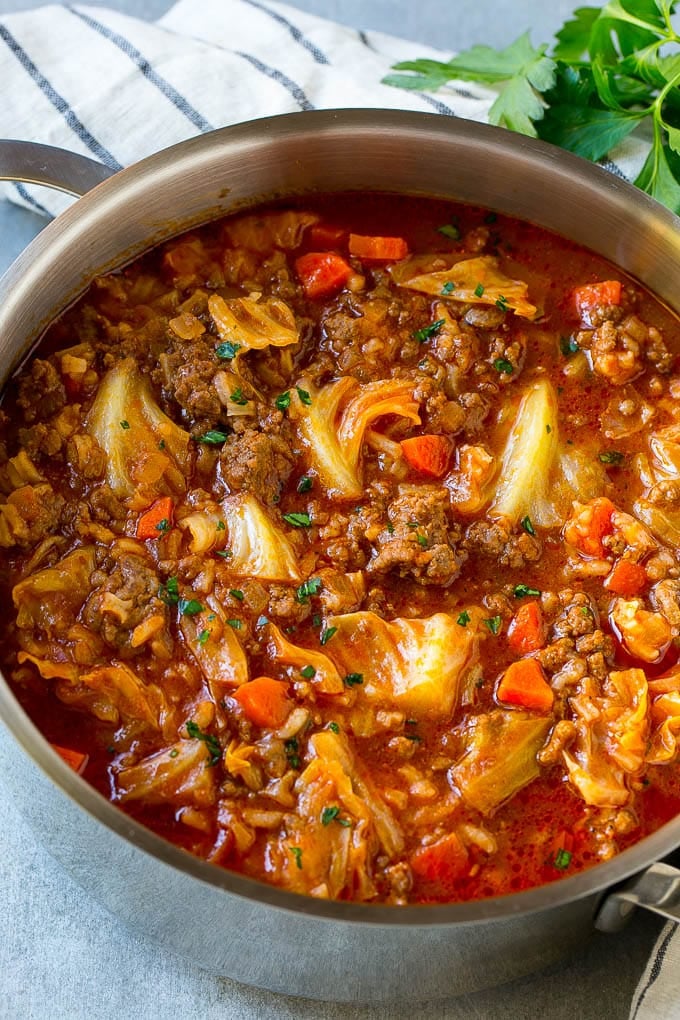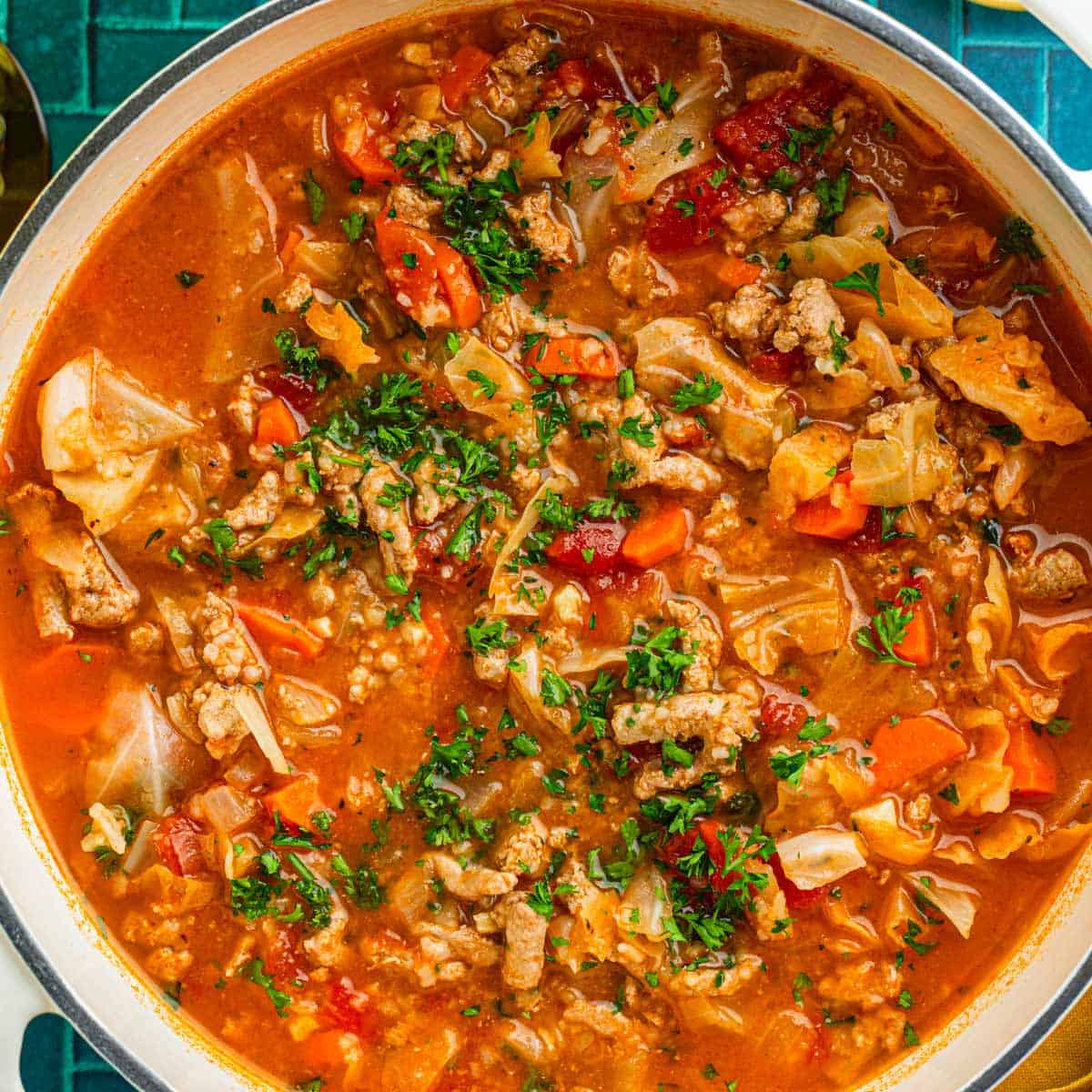Are you craving a comforting and flavorful meal that’s easy to make? I’m offering a deliciousrecipe for 20 Cabbage Roll Soup that brings all the goodness of traditional cabbage rolls into one hearty and quick-to-prepare soup.
Imagine coming home after a long day and being greeted by the warm aroma of a hearty, comforting soup. There’s something special about dishes that taste like a hug, and Cabbage Roll Soup perfectly captures that feeling. It’s a quick, flavorful meal that brings all the magic of traditional cabbage rolls into one easy pot.
Over the years, I’ve learned that simple ingredients can create the most satisfying dishes. This soup is proof that ease and flavor can go hand in hand. It’s perfect for busy nights or when you want a nourishing, delicious dinner without much fuss.
I’ve made this soup for family get-togethers and cozy weekends, and it never fails to bring smiles. By following these simple steps, you too can enjoy a warm, hearty bowl that tastes just like homemade. Prepare to make this beloved recipe your new go-to!
1. Cabbage Roll Soup

This Cabbage Roll Soup captures all the delicious flavors of traditional baked cabbage rolls but comes together in just about 45 minutes for an easy and satisfying meal. Simply brown the ground beef and onions, then add cabbage, carrots, tomatoes, rice, and spices, simmer for 25 minutes, and enjoy a hearty, one-pot dish that’s perfect for chilly nights and busy weeknights alike.
Read the Recipe: Cabbage Roll Soup
2. Cabbage Roll Soup [kitchenfunwithmy3sons.com]
![Cabbage Roll Soup [kitchenfunwithmy3sons.com]](https://kitchenfunwithmy3sons.com/wp-content/uploads/2019/10/cabbage-roll-soup.jpg)
This Cabbage Roll Soup is a hearty, flavorful dish perfect for a chilly day, featuring ground beef, chopped vegetables, rice, and tomato sauce all simmered together in one pot. It’s super easy to make—just brown the beef, toss in the veggies and seasonings, and let it cook for 25 minutes to enjoy a warm, comforting meal everyone will love!
Read the Recipe: Cabbage Roll Soup [kitchenfunwithmy3sons.com]
3. Cabbage Roll Soup Recipe

Enjoy a cozy, hearty bowl of Cabbage Roll Soup that combines ground beef, pork, rice, and cabbage simmered in a rich tomato broth—no rolling required! It’s the perfect comfort food for chilly days, made easy with simple ingredients and tastes just like grandma’s traditional cabbage rolls.
Read the Recipe: Cabbage Roll Soup Recipe
4. Cabbage Roll Soup [www.thekitchn.com]
![Cabbage Roll Soup [www.thekitchn.com]](https://cdn.apartmenttherapy.info/image/upload/f_auto,q_auto:eco,c_fill,g_auto,w_1500,ar_3:2/k%2FPhoto%2FRecipes%2F2020-12-cabbage-roll-soup%2F2020-12-14_ATK106503)
This Cabbage Roll Soup captures all the classic flavors of stuffed cabbage rolls in a quick, hearty dish that’s ready in about an hour. With browned beef, tender rice, tangy tomato broth, and plenty of cabbage and carrots, it’s a filling, delicious one-pot meal perfect for busy days!
Read the Recipe: Cabbage Roll Soup [www.thekitchn.com]
5. Cabbage Roll Soup [www.cookingclassy.com]
![Cabbage Roll Soup [www.cookingclassy.com]](https://www.cookingclassy.com/wp-content/uploads/2015/09/cabbage-roll-soup-20.jpg)
This Cabbage Roll Soup offers all the comforting flavors of traditional cabbage rolls but in a quick, one-pot meal that’s super easy to prepare. Simply brown the ground beef, sauté some veggies, then simmer everything with broth, tomatoes, and spices until tender—perfect for a hearty, flavorful dinner!
Read the Recipe: Cabbage Roll Soup [www.cookingclassy.com]
6. Cabbage Roll Soup [www.allrecipes.com]
![Cabbage Roll Soup [www.allrecipes.com]](https://www.allrecipes.com/thmb/GdT0kUWRjBBVi5RnuJrtKWAZ8V0=/1500x0/filters:no_upscale():max_bytes(150000):strip_icc()/6703510-cabbage-roll-soup-Lexie-4x3-1-acc4289512b8422cbe6779e8c0484b62.jpg)
Imagine cozying up with a hearty Cabbage Roll Soup that tastes just like the real thing, but in a fraction of the time! Simply simmer ground beef, tender cabbage, rice, and flavorful tomato sauce together for a nourishing, flavorful dish that’s perfect for sharing over crusty bread or garlic toast.
Read the Recipe: Cabbage Roll Soup [www.allrecipes.com]
7. Cabbage Roll Soup [www.saltandlavender.com]
![Cabbage Roll Soup [www.saltandlavender.com]](https://www.saltandlavender.com/wp-content/uploads/2019/11/cabbage-roll-soup-11.jpg)
This Cabbage Roll Soup is a hearty, budget-friendly dish bursting with savory flavors, featuring tender cabbage ribbons, juicy ground beef, and rice simmered in a rich tomato broth. It’s an easy, comforting meal that captures the classic taste of cabbage rolls but with much less effort—perfect for cozy winter nights!
Read the Recipe: Cabbage Roll Soup [www.saltandlavender.com]
8. Cabbage Roll Soup: A Comforting Twist on a Classic

Cabbage Roll Soup is a quick and comforting dish that captures all the flavors of traditional cabbage rolls in a single pot. Simply sauté ground beef, cabbage, rice, and seasonings, then simmer in a savory tomato broth for about 30 minutes—no rolling required!
Read the Recipe: Cabbage Roll Soup: A Comforting Twist on a Classic
9. Cabbage Roll Soup [www.delish.com]
![Cabbage Roll Soup [www.delish.com]](https://hips.hearstapps.com/hmg-prod/images/cabbage-roll-soup-index-661f019c15602.jpg?crop=1.00xw:1.00xh;0,0&resize=1200:*)
Imagine cozying up with a hearty, flavorful bowl of Cabbage Roll Soup that tastes just like the classic cabbage rolls but in a fraction of the time! This simple, two-step recipe combines ground beef, rice, tomatoes, and green cabbage, all simmered together with a touch of oregano, paprika, Worcestershire sauce, and apple cider vinegar for a comforting and satisfying meal.
Read the Recipe: Cabbage Roll Soup [www.delish.com]
10. Cabbage Roll Soup [www.fromvalerieskitchen.com]
![Cabbage Roll Soup [www.fromvalerieskitchen.com]](https://www.fromvalerieskitchen.com/wordpress/wp-content/uploads/2019/09/Cabbage-Roll-Soup-15.jpg)
This Cabbage Roll Soup is a hearty, flavor-packed dish made with lean ground beef, cabbage, carrots, and rice simmered in a savory broth with tomatoes and seasonings. It’s an easy one-pot wonder that captures all the comforting tastes of traditional stuffed cabbage rolls in a warm, nutritious soup!
Read the Recipe: Cabbage Roll Soup [www.fromvalerieskitchen.com]
11. Cabbage Roll Soup [www.thecountrycook.net]
![Cabbage Roll Soup [www.thecountrycook.net]](https://www.thecountrycook.net/wp-content/uploads/2024/09/thumbnail-Cabbage-Roll-Soup.jpg)
Cabbage Roll Soup is a thick, hearty dish packed with ground beef, rice, tomatoes, and cabbage, all simmered in a rich tomato broth that tastes just like classic stuffed cabbage rolls! In under an hour, you can enjoy a cozy, flavorful bowl that’s perfect for chilly evenings and easy to customize—think vegetarian or adjustments for a thinner soup!
Read the Recipe: Cabbage Roll Soup [www.thecountrycook.net]
12. Easy Unstuffed Cabbage Roll Soup (stovetop or slow cooker)

This Unstuffed Cabbage Roll Soup is a cozy, flavorful dish that captures all the delicious taste of stuffed cabbage rolls but in a quick and easy soup form. With tender ground beef, crisp cabbage, and savory tomato flavors simmered to perfection, it’s a hearty meal that comes together in just one pot—perfect for a comforting family dinner!
Read the Recipe: Easy Unstuffed Cabbage Roll Soup (stovetop or slow cooker)
13. Stuffed Cabbage Roll Soup

Stuffed Cabbage Roll Soup is a hearty, one-pot dish that captures all the flavors of traditional stuffed cabbage, but in a quick and easy soup form. With ground beef, rice, chopped cabbage, and a blend of spices and veggies, it’s a nourishing, budget-friendly meal that’s perfect for freezing and enjoying anytime!
Read the Recipe: Stuffed Cabbage Roll Soup
14. Cabbage Roll Soup [thecozyapron.com]
![Cabbage Roll Soup [thecozyapron.com]](https://thecozyapron.com/wp-content/uploads/2019/02/cabbage-roll-soup_thecozyapron_1.jpg)
This Cabbage Roll Soup is a cozy, hearty meal that captures the delicious flavors of classic cabbage rolls but in a quick, no-fuss bowl. It features tender shredded cabbage, lean ground beef, and rice simmered in a rich tomato broth, making every spoonful warm and comforting!
Read the Recipe: Cabbage Roll Soup [thecozyapron.com]
15. Cabbage Roll Soup [www.smalltownwoman.com]
![Cabbage Roll Soup [www.smalltownwoman.com]](https://www.smalltownwoman.com/wp-content/uploads/2020/02/Cabbage-Roll-Soup-Facebook.jpg)
Imagine the warm, comforting flavors of cabbage rolls transformed into a hearty, easy soup that’s perfect for any night. This Cabbage Roll Soup combines ground beef, fresh vegetables, tomatoes, and aromatic spices into a one-pot wonder that’s quick to make and full of wholesome goodness—no rolling required!
Read the Recipe: Cabbage Roll Soup [www.smalltownwoman.com]
16. Healthy Cabbage Roll Soup

This Healthy Cabbage Roll Soup is a warm, comforting dish that brings the delicious flavors of traditional cabbage rolls into a simple, hearty soup. Just simmer everything together — no rolling needed — for an easy, filling meal perfect for busy nights or cozy fall days!
Read the Recipe: Healthy Cabbage Roll Soup
17. Cabbage Roll Soup [www.sweetandsavoury.ca]
![Cabbage Roll Soup [www.sweetandsavoury.ca]](https://static.wixstatic.com/media/4d56f0_2b1aa7848e664e72a17e7d9452b1d7f1~mv2.jpg/v1/fill/w_1000,h_854,al_c,q_85,usm_0.66_1.00_0.01/4d56f0_2b1aa7848e664e72a17e7d9452b1d7f1~mv2.jpg)
This Cabbage Roll Soup is a hearty, flavorful dish made using the leftover cabbage water from boiling cabbage leaves—packed with nutrients and flavor—as its base. Simply sauté diced onions and garlic, add chopped vegetables, cabbage, and your favorite stock or broth, then simmer with tomato paste, diced tomatoes, spices, and rice for a thick, delicious soup that tastes just like cabbage rolls in a bowl!
Read the Recipe: Cabbage Roll Soup [www.sweetandsavoury.ca]
18. Cabbage Roll Soup [kaynutrition.com]
![Cabbage Roll Soup [kaynutrition.com]](https://kaynutrition.com/wp-content/uploads/2025/01/cabbage-roll-soup-1.jpg)
This Cabbage Roll Soup turns the classic stuffed cabbage dish into a quick, hearty one-pot meal full of flavor. Made with ground meat, cabbage, veggies, and rice, it’s high in protein and ready in under an hour, perfect for a cozy weeknight dinner or meal prep.
Read the Recipe: Cabbage Roll Soup [kaynutrition.com]
19. Cabbage Roll Soup [www.livingchirpy.com]
![Cabbage Roll Soup [www.livingchirpy.com]](https://www.livingchirpy.com/wp-content/uploads/2024/08/cabbagerollsoup.01.jpg)
Cabbage Roll Soup is a delicious, hearty dish that combines ground beef, cabbage, rice, and flavorful herbs into a comforting bowl—perfect for chilly days or busy weeknights. Simply brown the beef and onions, add the rest of the ingredients, and let it simmer until everything is tender and well-cooked for a satisfying, easy-to-make meal that freezes wonderfully for later fun!
Read the Recipe: Cabbage Roll Soup [www.livingchirpy.com]
20. Stuffed Cabbage Soup
:max_bytes(150000):strip_icc()/stuffed-cabbage-soup-281244-3x2-25bd0acc6bc545509e738997f0e4394f.jpg)
This Stuffed Cabbage Soup is a cozy, satisfying meal that captures all the flavors of classic stuffed cabbage rolls, but in a quick, one-pot dish. It’s made with tender ground beef, cabbage, and vegetables, simmered in a flavorful broth — perfect for an easy, delicious dinner with minimal cleanup.
Read the Recipe: Stuffed Cabbage Soup
